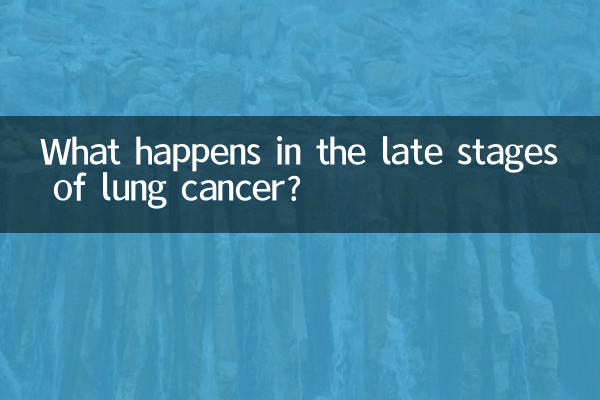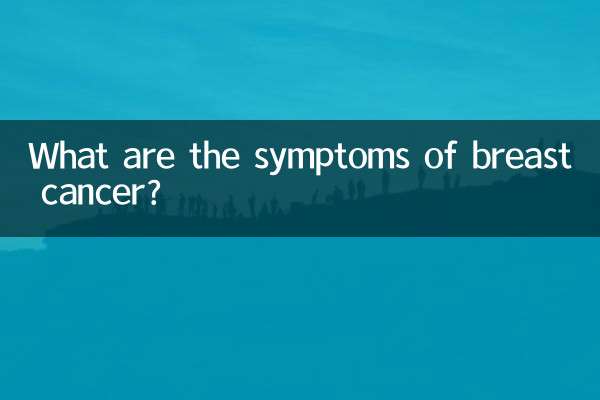What happens in the late stages of lung cancer?
In recent years, the incidence of lung cancer has increased year by year, especially the treatment and survival conditions of advanced lung cancer have attracted much attention. This article will combine the hot topics and hot content on the Internet in the past 10 days, and conduct a structured analysis of the symptoms, treatment methods, survival rates and patient care of late-stage lung cancer to help readers fully understand the current status of this disease.
1. Common symptoms of late stage lung cancer

Patients with advanced lung cancer often experience the following symptoms, which may vary from individual to individual:
| symptom | describe |
|---|---|
| persistent cough | The cough is frequent and difficult to relieve and may be accompanied by bloody sputum. |
| difficulty breathing | Patients often feel short of breath due to tumor compression or fluid accumulation in the lungs. |
| chest pain | The tumor invades the chest wall or nerves, causing persistent pain. |
| weight loss | The patient lost significant weight due to metabolic abnormalities and loss of appetite. |
| fatigue | Physical weakness and reduced ability to perform daily activities. |
2. Treatment methods for late stage lung cancer
Although late-stage lung cancer is difficult to cure, modern medicine provides a variety of treatments to extend survival and improve quality of life:
| Treatment | Applicable situations | Effect |
|---|---|---|
| Chemotherapy | patients with extensive metastases | It can shrink tumors and relieve symptoms, but has major side effects. |
| targeted therapy | Patients with specific genetic mutations | Accurately attacks cancer cells with minimal side effects and significant efficacy. |
| Immunotherapy | Patients with high PD-L1 expression | Activates the immune system and has better long-term effects. |
| radiotherapy | Local lesions or bone metastases | Relieve pain and control tumor growth. |
| palliative care | end stage patients | Focus on alleviating pain and improving quality of life. |
3. Survival rate data for advanced lung cancer
According to the latest statistics, the survival rate of late-stage lung cancer varies depending on treatment methods and individual differences:
| installment | 5 year survival rate | median survival time |
|---|---|---|
| Stage IV non-small cell lung cancer | About 5%-10% | 8-12 months |
| Stage IV small cell lung cancer | About 1%-3% | 6-10 months |
| Patients receiving targeted therapy | About 15%-30% | 18-24 months |
| patients receiving immunotherapy | About 20%-40% | 24-36 months |
4. Nursing suggestions for patients with advanced lung cancer
For patients with advanced lung cancer, family care and psychological support are particularly important. Here are some care tips:
1.pain management: Take painkillers on time to avoid worsening of pain and affecting quality of life.
2.nutritional support: Provide a high-protein, high-calorie diet, and use nutritional supplements when necessary.
3.psychological counseling: Patients are prone to anxiety and depression, and family members should stay with them and seek professional psychological consultation.
4.respiratory care: Maintain indoor air circulation and use oxygen equipment to relieve breathing difficulties if necessary.
5.Regular review: Even if the condition is stable, regular examinations are required to adjust the treatment plan.
5. Latest research progress
In the past 10 days, the following hot topics have been discussed in the field of lung cancer treatment:
1.New targeted drugs approved: A certain targeted drug targeting rare genetic mutations was approved by the FDA, bringing new hope to some patients.
2.Breakthrough in combined immune therapy: Studies show that immunotherapy combined with chemotherapy can significantly extend survival.
3.Artificial Intelligence Assisted Diagnosis: AI technology assists early screening and reduces the missed diagnosis rate.
Although late-stage lung cancer is difficult to cure, patients can still strive for longer survival time and higher quality of life through scientific treatment and care. In the future, with the advancement of medical technology, there will be more breakthroughs in the treatment of lung cancer.

check the details

check the details